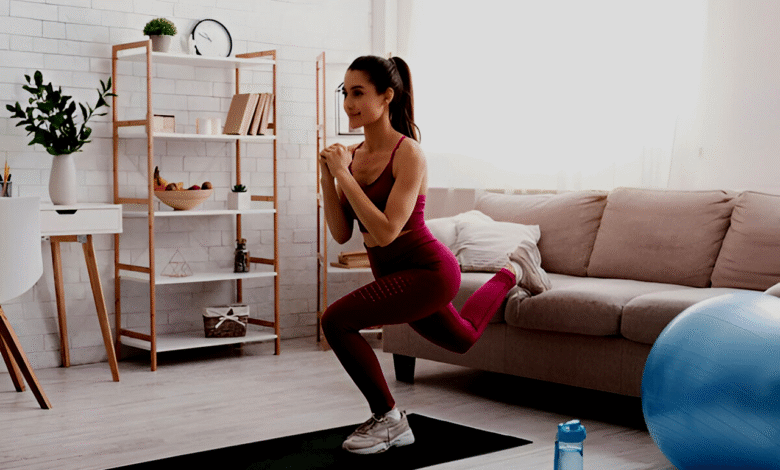
Creating a simple at-home workout routine is one of the most convenient and effective ways to stay fit, especially when time, budget, or access to a gym is limited. With just a little planning, you can design a personalized exercise plan that builds strength, boosts endurance, and enhances flexibility all from the comfort of your living room. Whether you’re a beginner or an experienced fitness enthusiast, this guide will help you structure a balanced routine that fits your goals and lifestyle.
The best part about a simple at-home workout routine is that it requires minimal equipment and can be adapted to any fitness level. By focusing on bodyweight exercises, cardio movements, and proper recovery, you can achieve impressive results without expensive gear or complicated setups. In the following sections, we’ll break down how to assess your fitness needs, choose the right exercises, and stay motivated for long-term success. Let’s get started on building a workout plan that works for you.
How to Create a Simple At-Home Workout Routine
Evaluating Your Current Fitness Level
Before designing your simple at-home workout routine, take an honest assessment of where you stand. Ask yourself Can I perform basic exercises (like push-ups, squats, or planks) with proper form? How long can I sustain cardio activities (such as jogging in place or jumping jacks) without exhaustion? Do I have any injuries or limitations that require modified movements? Categorize yourself as Beginner If you’re new to exercise or returning after a long break. Intermediate If you can comfortably do 10–15 reps of bodyweight exercises. Advanced If you can perform challenging variations (like pistol squats or plyometric moves). This self-assessment ensures your routine matches your capabilities, preventing burnout or injury.
Defining Clear Fitness Goals
Your simple at-home workout routine should align with specific objectives. Common goals include Weight Loss: Focus on high-intensity cardio (HIIT) and full-body circuits to burn calories. Muscle Building: Prioritize strength training with progressive overload (e.g., adding resistance bands or weights). Endurance: Incorporate longer cardio sessions (like dance workouts or cycling) and low-rest strength circuits. General Fitness: Mix strength, cardio, and flexibility exercises for balanced health.
Choose the Right Exercises
Essential Components of a Balanced Routine
A truly effective simple at-home workout routine must incorporate three key elements Strength Training: Builds lean muscle and boosts metabolism through bodyweight exercises like push-ups (targeting chest/arms), squats and planks. For progression, add resistance bands or household items (like water bottles as light weights) to increase difficulty gradually. Aerobic exercise Improves heart health and burns calories through dynamic movements. Jump rope, burpees (full-body intensity), or dance workouts (fun cardio) elevate your heart rate efficiently in short bursts. Flexibility/Mobility Work: Enhances movement quality and prevents injuries. Daily 5–10 minutes of yoga or dynamic stretches pre-workout primes muscles, while static stretches post-workout aid recovery.
How to Integrate Each Component
To maximize results in your simple at-home workout routine, strategic planning is key aim for a balanced weekly split that alternates focus areas while maintaining efficiency. For example, dedicate Monday/Wednesday/Friday to strength and mobility with exercises like squats, push-ups, planks, and yoga stretches to build muscle and improve flexibility. On Tuesday/Thursday, prioritize cardio and core work through high-energy movements like jump rope, burpees, and bicycle crunches to boost endurance and strengthen your midsection, followed by a proper cool-down.
Structure Your Workout Plan
A balanced weekly routine could look like this Monday Upper body strength (push-ups, triceps dips, shoulder presses). Wednesday Lower body strength (squats, lunges, calf raises). Friday Full-body HIIT (burpees, mountain climbers, jumping jacks). Sunday Yoga or stretching for recovery
Warm-Up and Cool Down
Never underestimate the power of proper warm-ups and cool-downs in your simple at-home workout routine. Starting with 5-10 minutes of dynamic movements (like arm circles, leg swings, or light jogging in place) increases blood flow, boosts flexibility, and preps your muscles to perform safely at their best. After exercising, dedicate 5 minutes to static stretching (holding stretches for 20-30 seconds) focusing on worked muscle groups this helps prevent stiffness, reduces next-day soreness, and gradually lowers your heart rate.
Track Progress and Stay Motivated
Tracking Progress for Measurable Results
Keeping a workout journal or using fitness apps (like Nike Training Club or MyFitnessPal) creates accountability and reveals patterns. Record Workout Details Exercises, sets/reps, weights used, and rest times. Performance Metrics Track improvements (e.g., holding a plank 10 sec longer, adding 5 more push-ups). How You Feel Energy levels, soreness, and sleep quality to gauge recovery. Why It Works Visible progress (even small gains) reinforces commitment and helps adjust routines effectively.
Celebrating Small Wins to Sustain Motivation
The key to lasting motivation in your simple at-home workout routine lies in consciously celebrating every step forward start by acknowledging milestones like completing 10 consistent workouts or finally nailing that challenging exercise you’ve been practicing. Pay equal attention to non-scale victories, whether it’s standing taller with improved posture, noticing clothes fitting looser, or breezing upstairs without getting winded, as these tangible signs of progress often matter more than numbers on a scale. For an extra motivational boost, share your achievements with supportive friends or on social media, since verbalizing wins.
Adapt and Overcome Challenges
Breaking Through Plateaus with Strategic Adjustments
When your simple at-home workout routine hits a plateau, strategic adjustments can jumpstart progress by forcing your body to adapt to new challenges. Start by modifying exercises upgrade basic moves to advanced variations like replacing standard push-ups with decline push-ups (feet elevated) or transforming regular squats into explosive jump squats to engage muscles differently. Next, increase intensity through simple tweaks: add more reps per set (10→15), shorten rest periods (30→15 seconds), or incorporate resistance using bands or household items as makeshift weights.
The Power of Consistency Over Perfection
The key to long-term success with your simple at-home workout routine lies in embracing consistency over perfection aim for 3-4 doable workouts weekly rather than stressing over flawless sessions, since even 10-minute movement breaks maintain crucial momentum. Shift your focus beyond the scale by celebrating non-scale victories like increased energy, deeper sleep, or mastering proper form, as these tangible improvements prove your progress just as powerfully as numbers. When life interrupts your plan (as it inevitably will), practice flexibility by adjusting your schedule rather than abandoning efforts.
Read More: How to Apply for FAFSA in the USA A Step-by-Step Guide
Conclusion
A simple at-home workout routine proves that you don’t need a gym membership or fancy equipment to stay in shape. By incorporating bodyweight exercises, cardio bursts, and flexibility work, you can build strength, boost endurance, and improve overall health all within the comfort of your home. The key is consistency; even short, focused workouts can yield significant results when performed regularly. Adjust the intensity as needed, listen to your body, and make fitness a sustainable part of your daily routine.
Ultimately, the beauty of a simple at-home workout routine lies in its flexibility and accessibility. Whether you have 15 minutes or an hour, you can tailor your sessions to fit your schedule and fitness level. Stay patient, track your progress, and celebrate small victories along the way. With dedication and smart planning, your home can become the perfect place to achieve your fitness goals no gym required. Keep moving, stay motivated, and enjoy the journey to a healthier, stronger you.
FAQs
How long should an at-home workout be?
Aim for 30-45 minutes per session, including warm-up and cool-down.
Do I need equipment for home workouts?
No, bodyweight exercises work well, but resistance bands or dumbbells can add variety.
How often should I work out at home?
3-5 times per week is ideal, with rest days for recovery.
Can I lose weight with home workouts?
Yes, combining strength training and cardio with a healthy diet promotes weight loss.
How do I stay motivated?
Set small goals, track progress, and switch up exercises to avoid boredom.







